Degradation of Levofloxacin by Electroactivated Sodium Persulfate on Carbon Cloth Cathode Modified with Cerium-Based Metal Organic Frameworks (Ce-MOF) Derivatives
Abstract
1. Introduction
2. Experimental Section
2.1. Materials and Reagents
2.2. Preparation of Sodium Persulphate (PMS)
2.3. Preparation of Ce-MOF Derivatives (Ce-MOF-T) and Electrodes
2.4. Characterization
2.5. LFX Degradation Experiments
3. Results and Discussion
3.1. Structural and Morphological Characterization of Ce-MOF-T
3.2. LFX Degradation Study
3.2.1. Effect of PMS Activation Mode on the Degradation Rate of LFX
3.2.2. Effect of Calcined Temperature
3.2.3. The Effect of Ce-MOF-550 Loading
3.2.4. Effect of PMS Concentration
3.2.5. Effect of pH
3.2.6. Effect of Current Density
3.2.7. Effect of LFX Concentration
3.3. Stability Testing
3.3.1. Structural Analysis of Electrode Materials before and after Reaction
3.3.2. Efficiency of LFX Degradation in Recycling Tests
3.3.3. Study of the LFX Degradation Mechanism
4. Conclusions
Author Contributions
Funding
Data Availability Statement
Acknowledgments
Conflicts of Interest
References
- Lv, H.; Han, P.; Li, X.; Mu, Z.; Zuo, Y.; Wang, X.; Tan, Y.; He, G.; Jin, H.; Sun, C.; et al. Electrocatalytic Degradation of Levofloxacin, a Typical Antibiotic in Hospital Wastewater. Materials 2021, 14, 6814. [Google Scholar] [CrossRef] [PubMed]
- Huang, Z.-H.; Liu, J.-M.; Ji, Z.-Y.; Yuan, P.; Guo, X.-F.; Li, S.-M.; Li, H.; Yuan, J.-S. Effective and continuous degradation of levofloxacin via the graphite felt electrode loaded with Fe3O4. Sep. Purif. Technol. 2022, 281, 119902. [Google Scholar] [CrossRef]
- Hamdi El Najjar, N.; Touffet, A.; Deborde, M.; Journel, R.; Leitner, N.K.V. Levofloxacin oxidation by ozone and hydroxyl radicals: Kinetic study, transformation products and toxicity. Chemosphere 2013, 93, 604–611. [Google Scholar] [CrossRef] [PubMed]
- An, T.; Yang, H.; Song, W.; Li, G.; Luo, H.; Cooper, W.J. Mechanistic Considerations for the Advanced Oxidation Treatment of Fluoroquinolone Pharmaceutical Compounds using TiO2 Heterogeneous Catalysis. J. Phys. Chem. A 2010, 114, 2569–2575. [Google Scholar] [CrossRef] [PubMed]
- Gong, Y.; Li, J.; Zhang, Y.; Zhang, M.; Tian, X.; Wang, A. Partial degradation of levofloxacin for biodegradability improvement by electro-Fenton process using an activated carbon fiber felt cathode. J. Hazard. Mater. 2016, 304, 320–328. [Google Scholar] [CrossRef] [PubMed]
- Comninellis, C.; Kapalka, A.; Malato, S.; Parsons, S.A.; Poulios, I.; Mantzavinos, D. Advanced oxidation processes for water treatment: Advances and trends for R&D. J. Chem. Technol. Biotechnol. 2008, 83, 769–776. [Google Scholar]
- M’Arimi, M.M.; Mecha, C.A.; Kiprop, A.K.; Ramkat, R. Recent trends in applications of advanced oxidation processes (AOPs) in bioenergy production: Review. Renew. Sustain. Energy Rev. 2020, 121, 109669. [Google Scholar] [CrossRef]
- Ike, I.A.; Linden, K.G.; Orbell, J.D.; Duke, M. Critical review of the science and sustainability of persulphate advanced oxidation processes. Chem. Eng. J. 2018, 338, 651–669. [Google Scholar] [CrossRef]
- Ding, Y.; Fu, L.; Peng, X.; Lei, M.; Wang, C.; Jiang, J. Copper catalysts for radical and nonradical persulfate based advanced oxidation processes: Certainties and uncertainties. Chem. Eng. J. 2022, 427, 131776. [Google Scholar] [CrossRef]
- Wang, S.; Wang, J. Successive non-radical and radical process of peroxymonosulfate-based oxidation using various activation methods for enhancing mineralization of sulfamethoxazole. Chemosphere 2021, 263, 127964. [Google Scholar] [CrossRef]
- Huang, S.; Guo, X.; Duan, W.; Cheng, X.; Zhang, X.; Li, Z. Degradation of high molecular weight polyacrylamide by alkali-activated persulfate: Reactivity and potential application in filter cake removal before cementing. J. Pet. Sci. Eng. 2019, 174, 70–79. [Google Scholar] [CrossRef]
- Zhang, Z.-w.; Wang, S.; Chen, M.-r.; Bao, N.-n.; Wang, X.-w.; Chen, F.-j.; Ji, G.-j.; Shen, L.; Lu, X.-L.; Song, A.-j. Construction of Fe9S10@Fe2O3@Fe3S4 conductor-semiconductor type heterojunction as photoactivator of peroxymonosulfate toward the degradation of Malachite Green. Chem. Phys. Lett. 2021, 781, 139001. [Google Scholar] [CrossRef]
- Hu, C.-Y.; Hou, Y.-Z.; Lin, Y.-L.; Deng, Y.-G.; Hua, S.-J.; Du, Y.-F.; Chen, C.-W.; Wu, C.-H. Investigation of iohexol degradation kinetics by using heat-activated persulfate. Chem. Eng. J. 2020, 379, 122403. [Google Scholar] [CrossRef]
- Gu, X.; Lu, S.; Li, L.; Qiu, Z.; Sui, Q.; Lin, K.; Luo, Q. Oxidation of 1,1,1-Trichloroethane Stimulated by Thermally Activated Persulfate. Ind. Eng. Chem. Res. 2011, 50, 11029–11036. [Google Scholar] [CrossRef]
- Qu, J.; Liu, R.; Bi, X.; Li, Z.; Li, K.; Hu, Q.; Zhang, X.; Zhang, G.; Ma, S.; Zhang, Y. Remediation of atrazine contaminated soil by microwave activated persulfate system: Performance, mechanism and DFT calculation. J. Clean. Prod. 2023, 399, 136546. [Google Scholar] [CrossRef]
- Hu, L.; Zhang, G.; Wang, Q.; Wang, X.; Wang, P. Effect of Microwave Heating on Persulfate Activation for Rapid Degradation and Mineralization of p-Nitrophenol. ACS Sustain. Chem. Eng. 2019, 7, 11662–11671. [Google Scholar] [CrossRef]
- García-Cervilla, R.; Santos, A.; Romero, A.; Lorenzo, D. Remediation of soil contaminated by lindane wastes using alkaline activated persulfate: Kinetic model. Chem. Eng. J. 2020, 393, 124646. [Google Scholar] [CrossRef]
- Dominguez, C.M.; Rodriguez, V.; Montero, E.; Romero, A.; Santos, A. Abatement of dichloromethane using persulfate activated by alkali: A kinetic study. Sep. Purif. Technol. 2020, 241, 116679. [Google Scholar] [CrossRef]
- Gao, F.; Li, Y.; Xiang, B. Degradation of bisphenol A through transition metals activating persulfate process. Ecotoxicol. Environ. Saf. 2018, 158, 239–247. [Google Scholar] [CrossRef]
- Anushree, C.; Nanda Gopala Krishna, D.; Philip, J. Efficient Dye Degradation via Catalytic Persulfate Activation using Iron Oxide-Manganese Oxide Core-Shell Particle Doped with Transition Metal Ions. J. Mol. Liq. 2021, 337, 116429. [Google Scholar] [CrossRef]
- Liu, J.; Zhong, S.; Song, Y.; Wang, B.; Zhang, F. Degradation of tetracycline hydrochloride by electro-activated persulfate oxidation. J. Electroanal. Chem. 2018, 809, 74–79. [Google Scholar] [CrossRef]
- Dhiman, R.; VishnuRadhan, R.; Eldho, T.I.; Inamdar, A. Flood risk and adaptation in Indian coastal cities: Recent scenarios. Appl. Water Sci. 2018, 9, 5. [Google Scholar] [CrossRef]
- Adhami, S.; Jamshidi-Zanjani, A.; Darban, A.K. Phenanthrene removal from the contaminated soil using the electrokinetic-Fenton method and persulfate as an oxidizing agent. Chemosphere 2021, 266, 128988. [Google Scholar] [CrossRef] [PubMed]
- Pan, X.; Chen, J.; Wu, N.; Qi, Y.; Xu, X.; Ge, J.; Wang, X.; Li, C.; Qu, R.; Sharma, V.K.; et al. Degradation of aqueous 2,4,4′-Trihydroxybenzophenone by persulfate activated with nitrogen doped carbonaceous materials and the formation of dimer products. Water Res. 2018, 143, 176–187. [Google Scholar] [CrossRef] [PubMed]
- Jing, B.; Zhou, J.; Li, D.; Ao, Z. Computational study on persulfate activation by two-dimensional carbon materials with various nitrogen proportions for carbamazepine oxidation in wastewater: The essential role of graphitic N atoms. J. Hazard. Mater. 2023, 442, 130074. [Google Scholar] [CrossRef] [PubMed]
- Sun, X.; Liu, Z.; Sun, Z. Electro-enhanced degradation of atrazine via Co-Fe oxide modified graphite felt composite cathode for persulfate activation. Chem. Eng. J. 2022, 433, 133789. [Google Scholar] [CrossRef]
- Long, Y.; Feng, Y.; Li, X.; Suo, N.; Chen, H.; Wang, Z.; Yu, Y. Removal of diclofenac by three-dimensional electro-Fenton-persulfate (3D electro-Fenton-PS). Chemosphere 2019, 219, 1024–1031. [Google Scholar] [CrossRef] [PubMed]
- Zheng, J.; Wang, Z.; Chen, Z.; Zuo, S. Mechanism of CeO2 synthesized by thermal decomposition of Ce-MOF and its performance of benzene catalytic combustion. J. Rare Earths 2021, 39, 790–796. [Google Scholar] [CrossRef]
- Gong, S.; Sun, Y.; Zheng, K.; Jiang, G.; Li, L.; Feng, J. Degradation of levofloxacin in aqueous solution by non-thermal plasma combined with Ag3PO4/activated carbon fibers: Mechanism and degradation pathways. Sep. Purif. Technol. 2020, 250, 117264. [Google Scholar] [CrossRef]
- Zhong, Y.; Shih, K.; Diao, Z.; Song, G.; Su, M.; Hou, L.; Chen, D.; Kong, L. Peroxymonosulfate activation through LED-induced ZnFe2O4 for levofloxacin degradation. Chem. Eng. J. 2021, 417, 129225. [Google Scholar] [CrossRef]
- Wei, S.; Fan, S.; Zhang, M.; Ren, J.; Jia, B.; Wang, Y.; Wu, R.; Fang, Z.; Liang, Q. Dye-sensitized Bi2MoO6 for highly efficient photocatalytic degradation of levofloxacin under LED light irradiation, Mater. Today Sustain. 2023, 21, 100311. [Google Scholar]
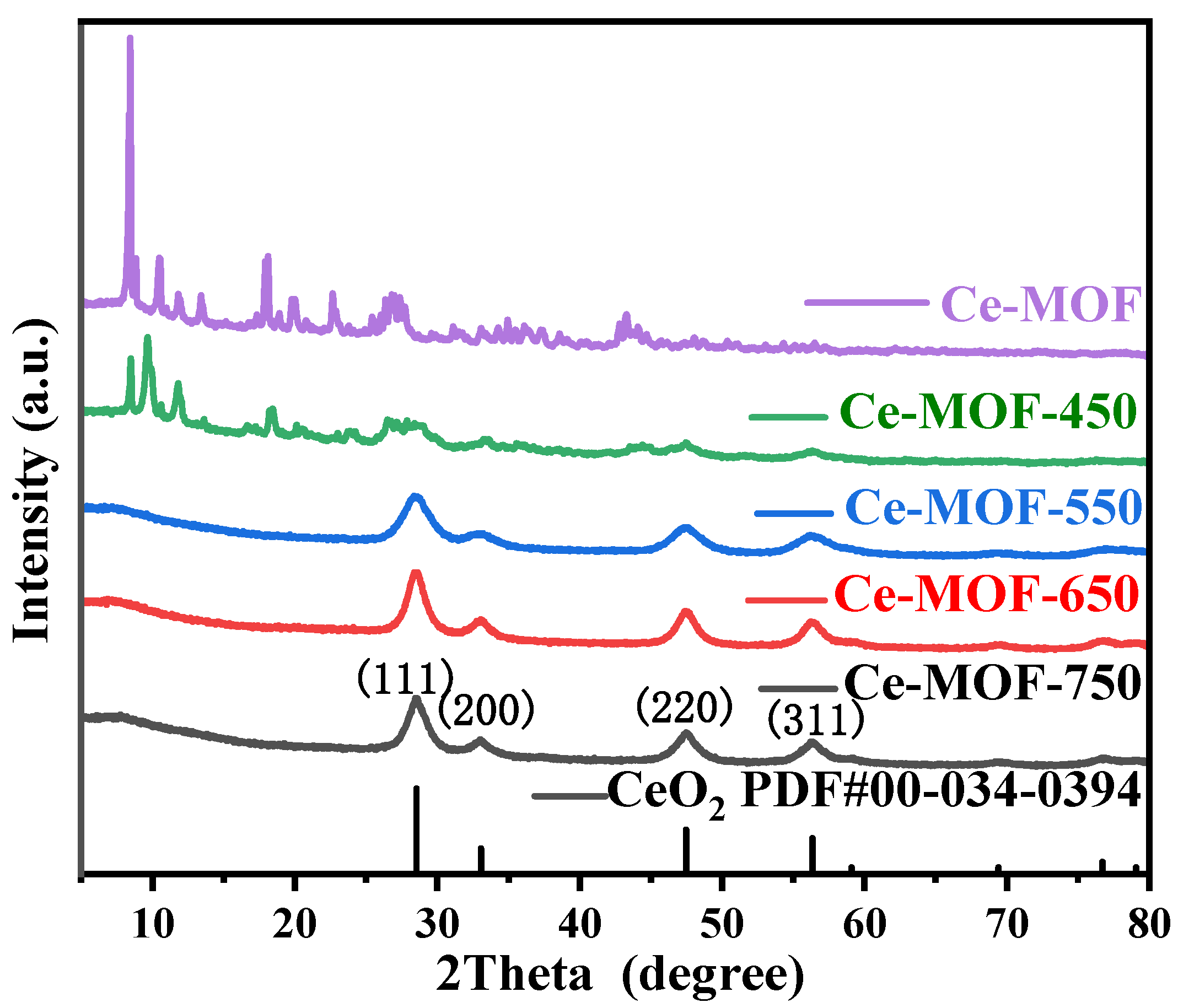
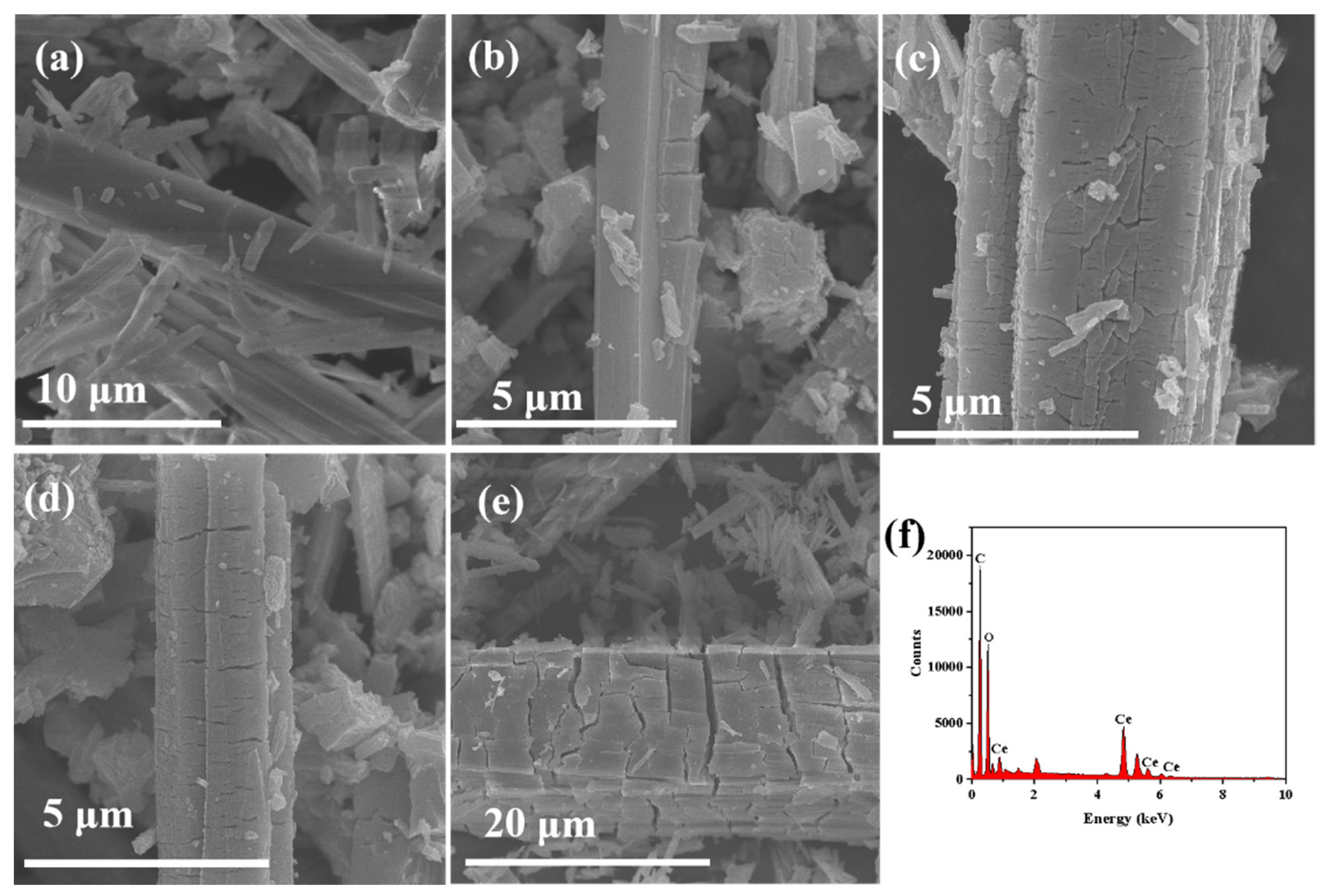

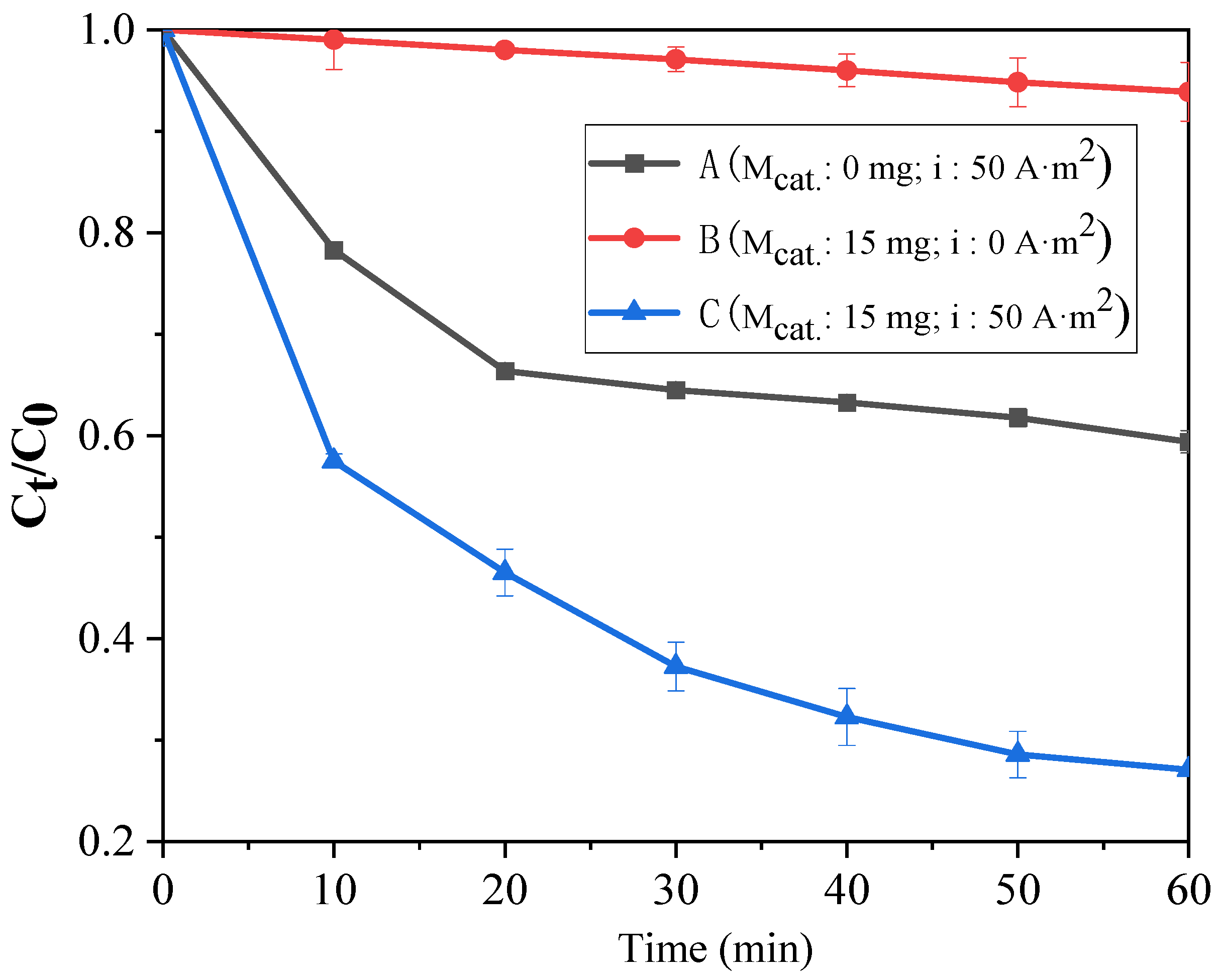
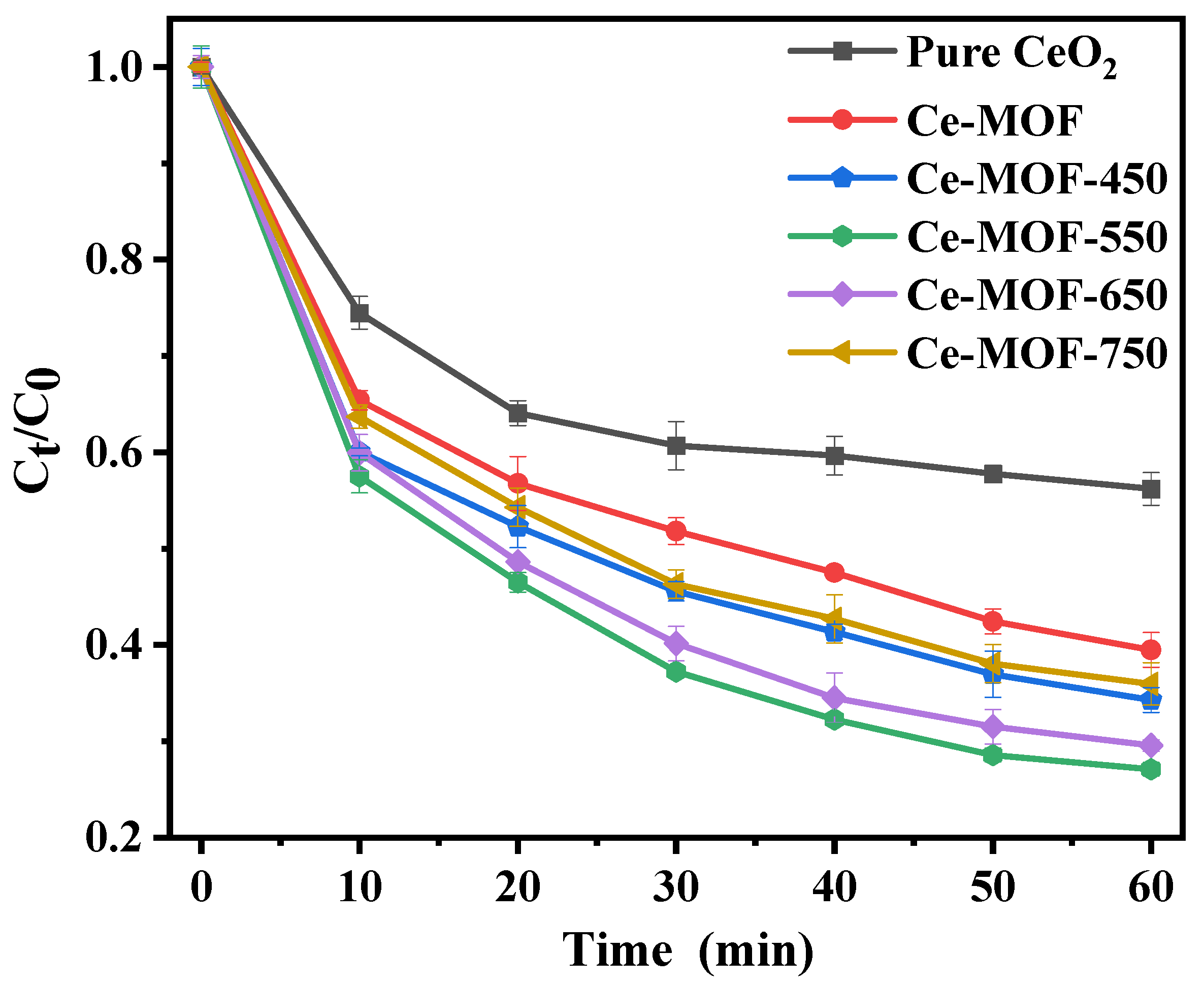
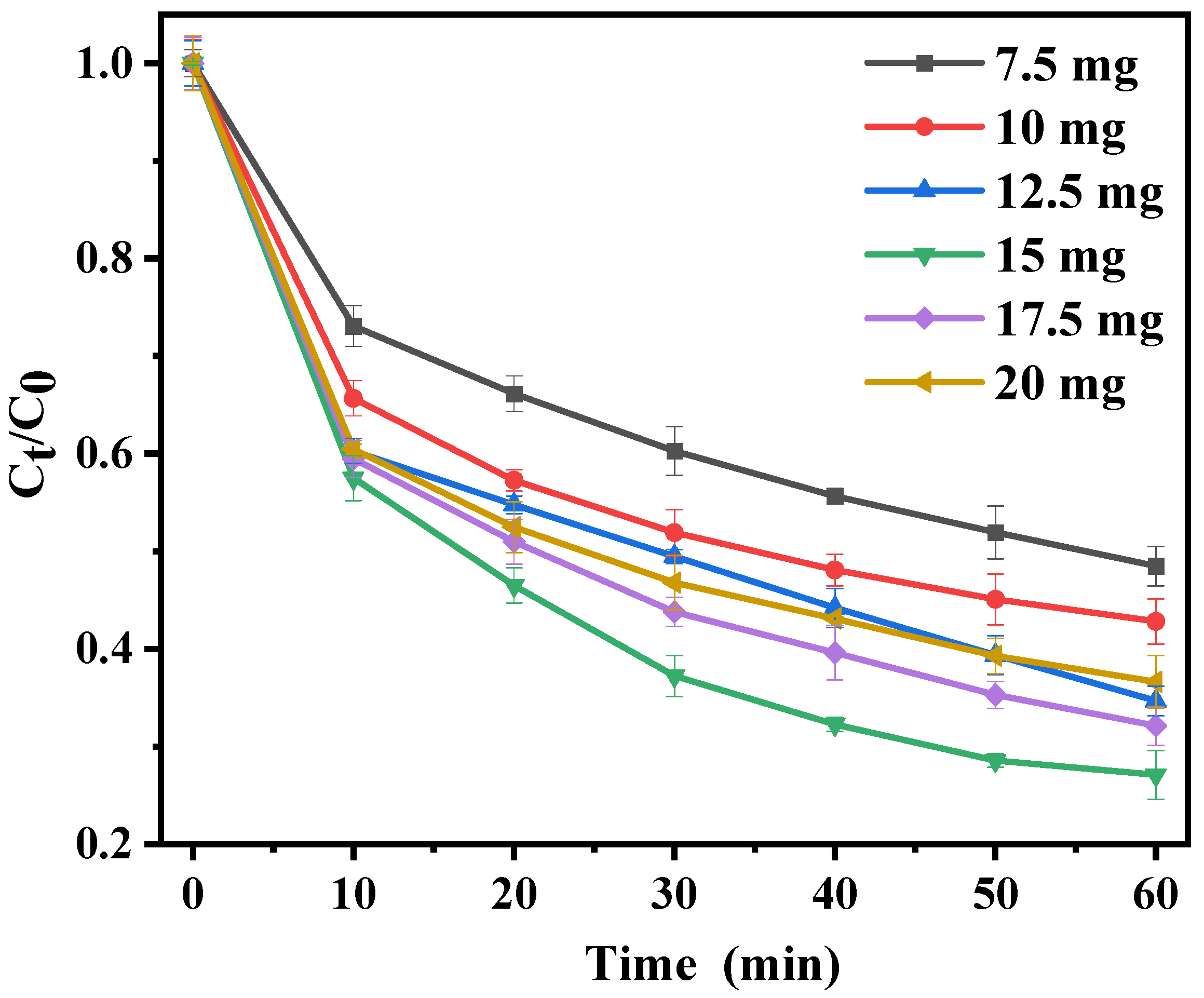
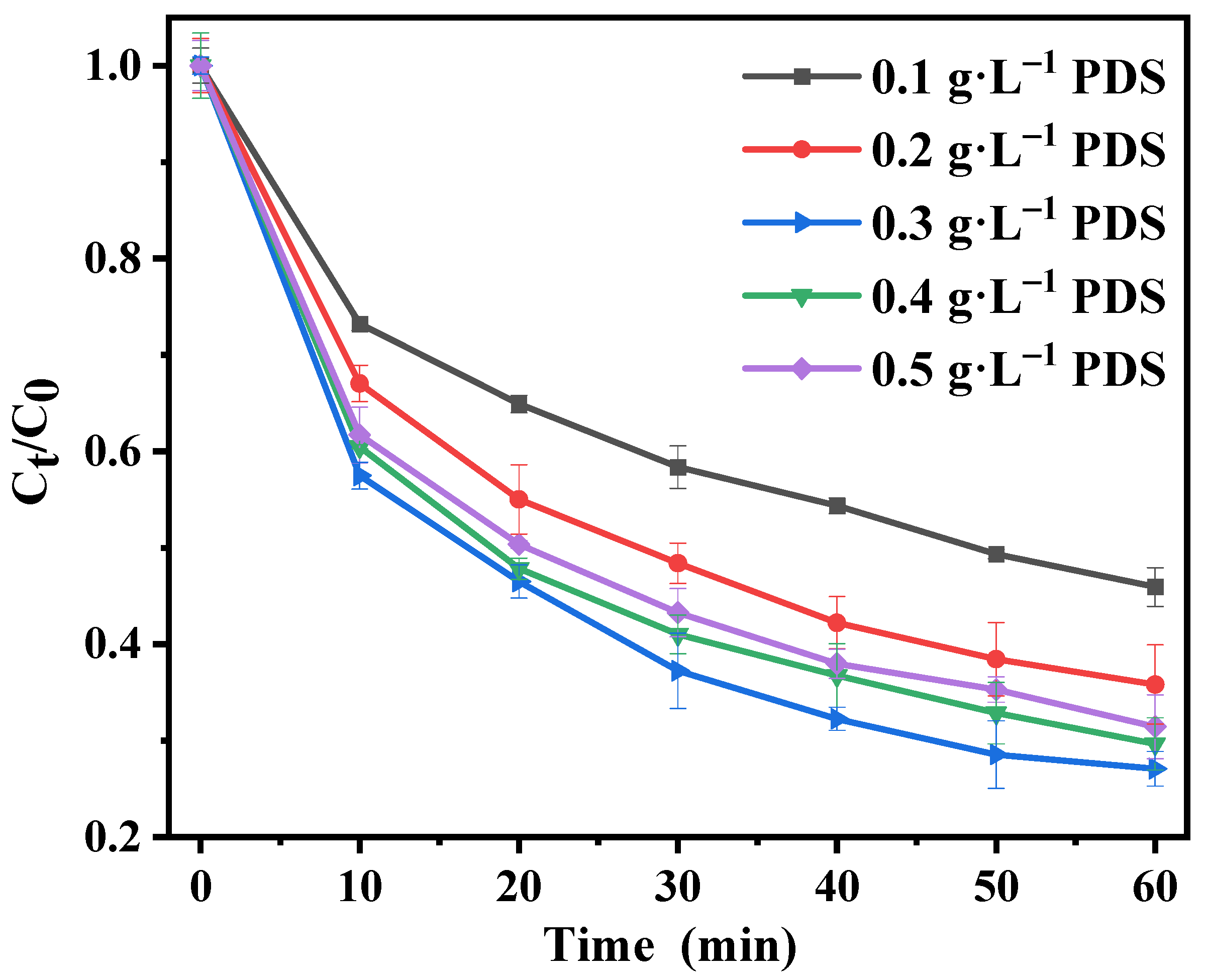
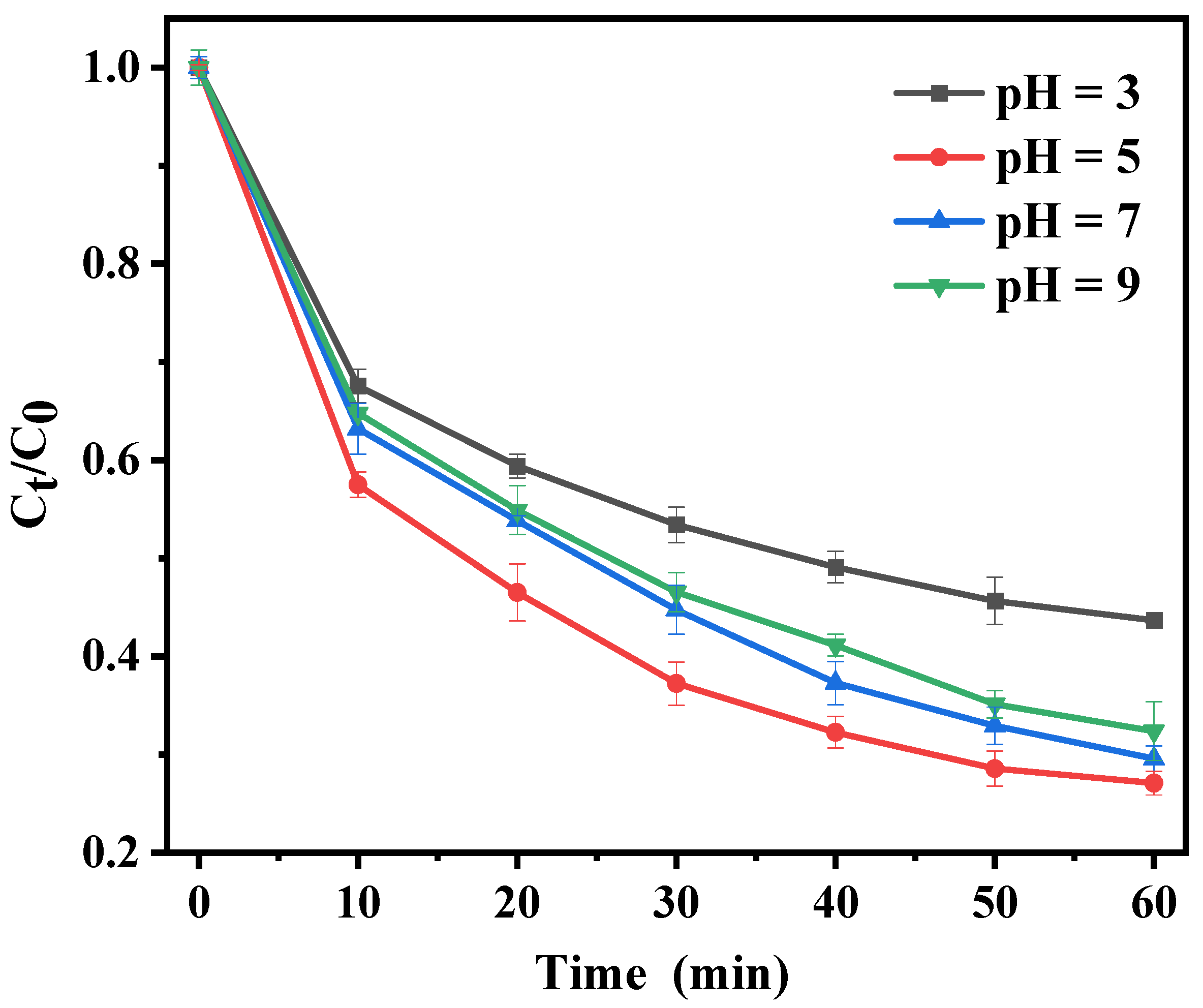

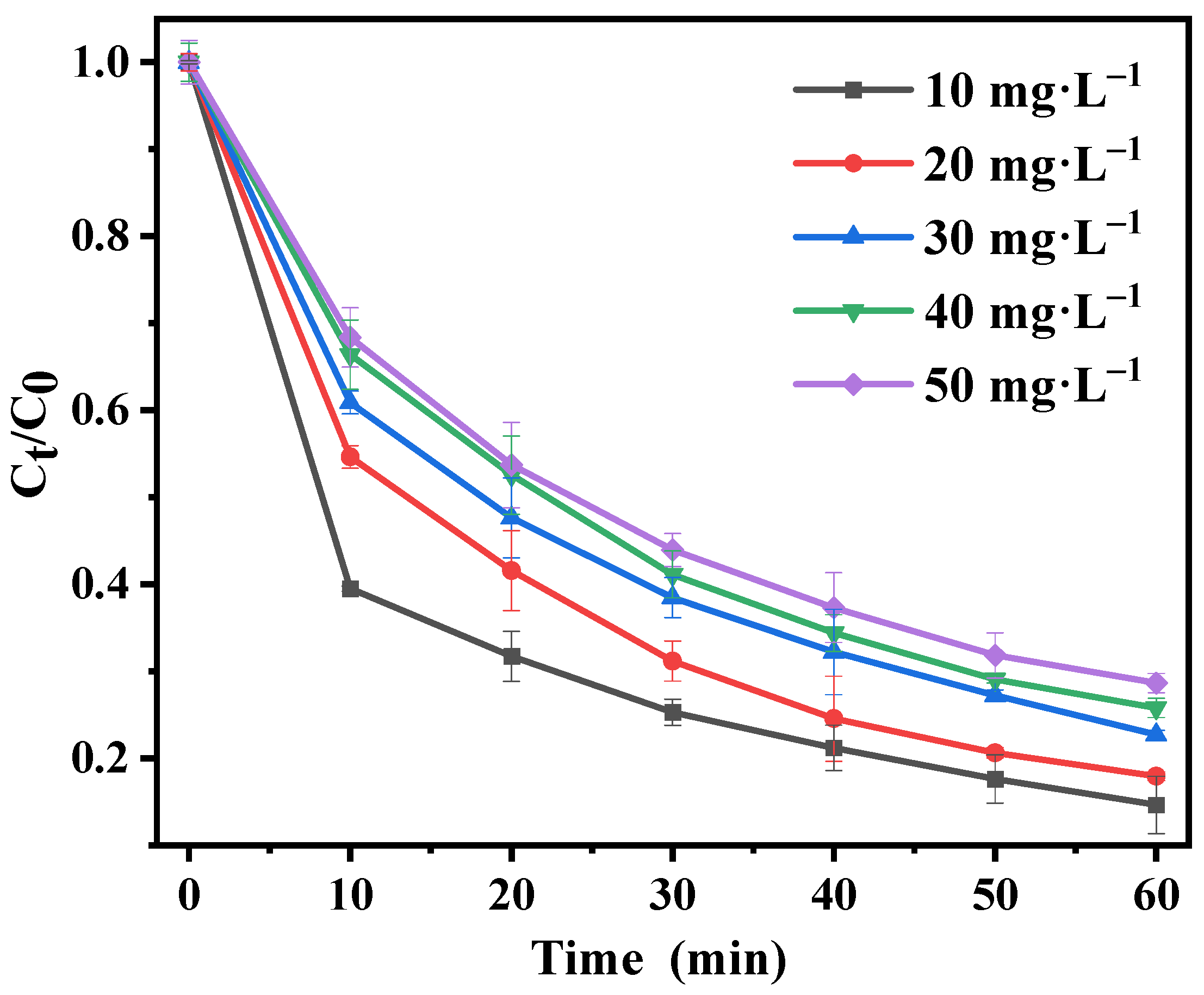
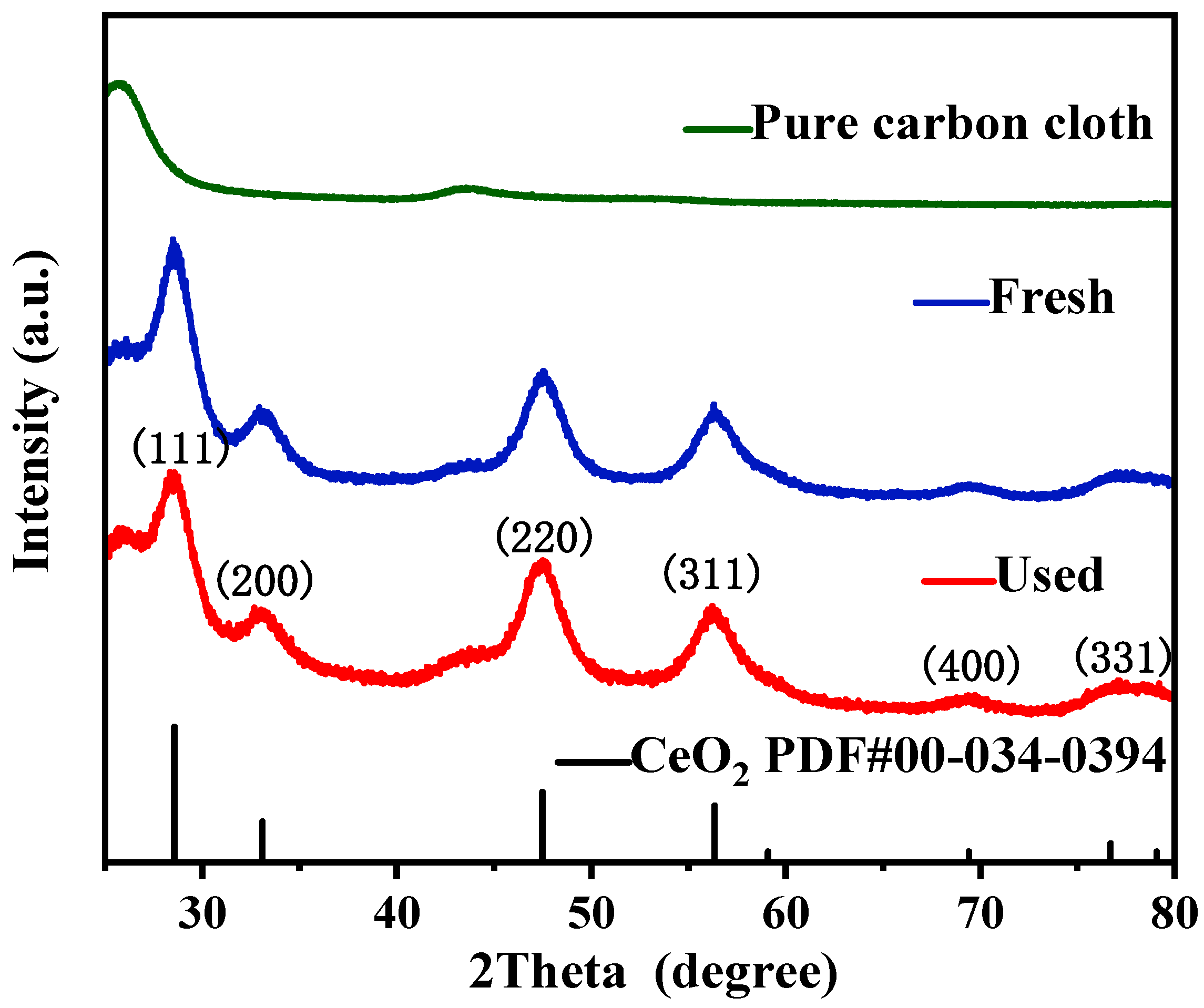

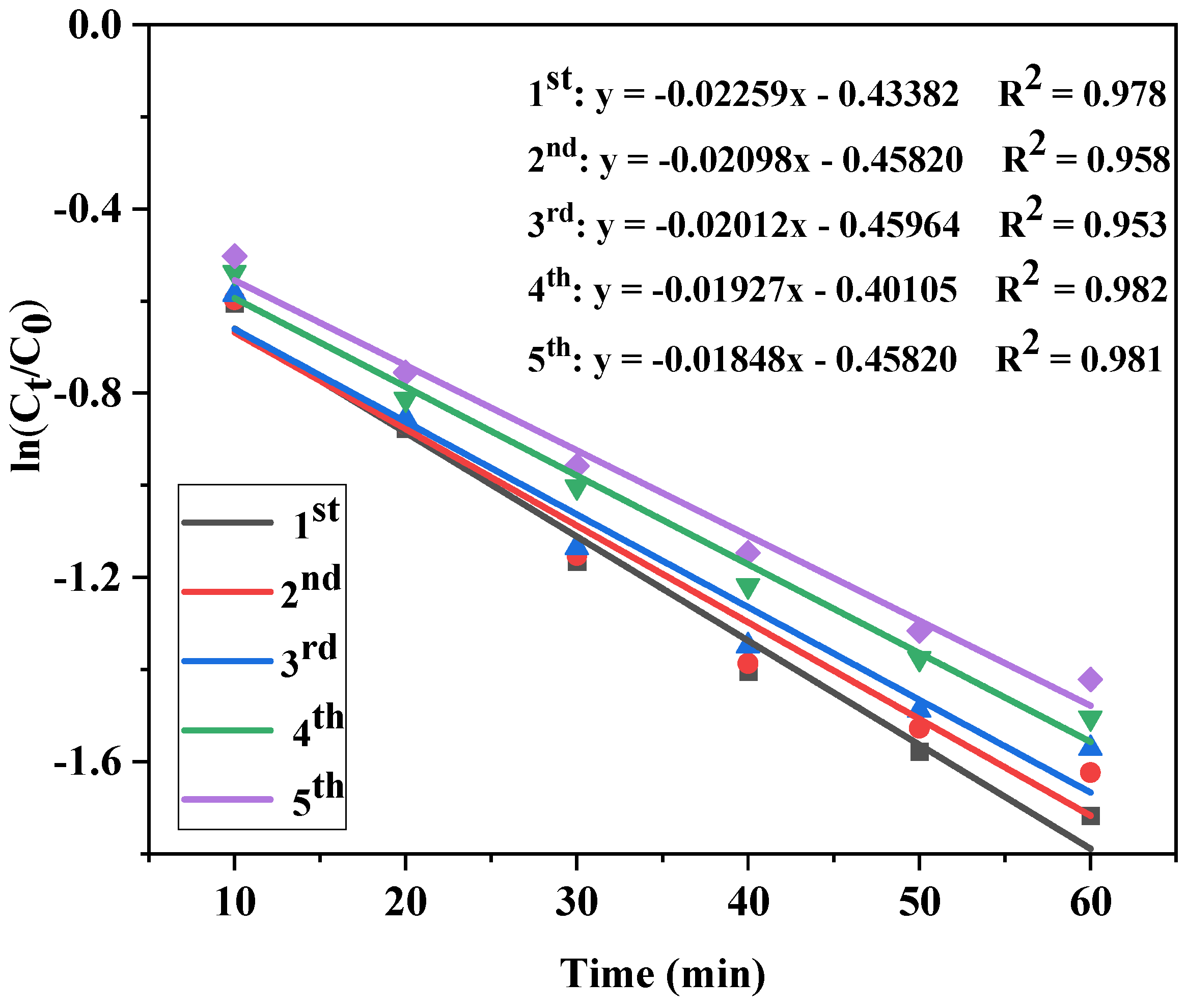
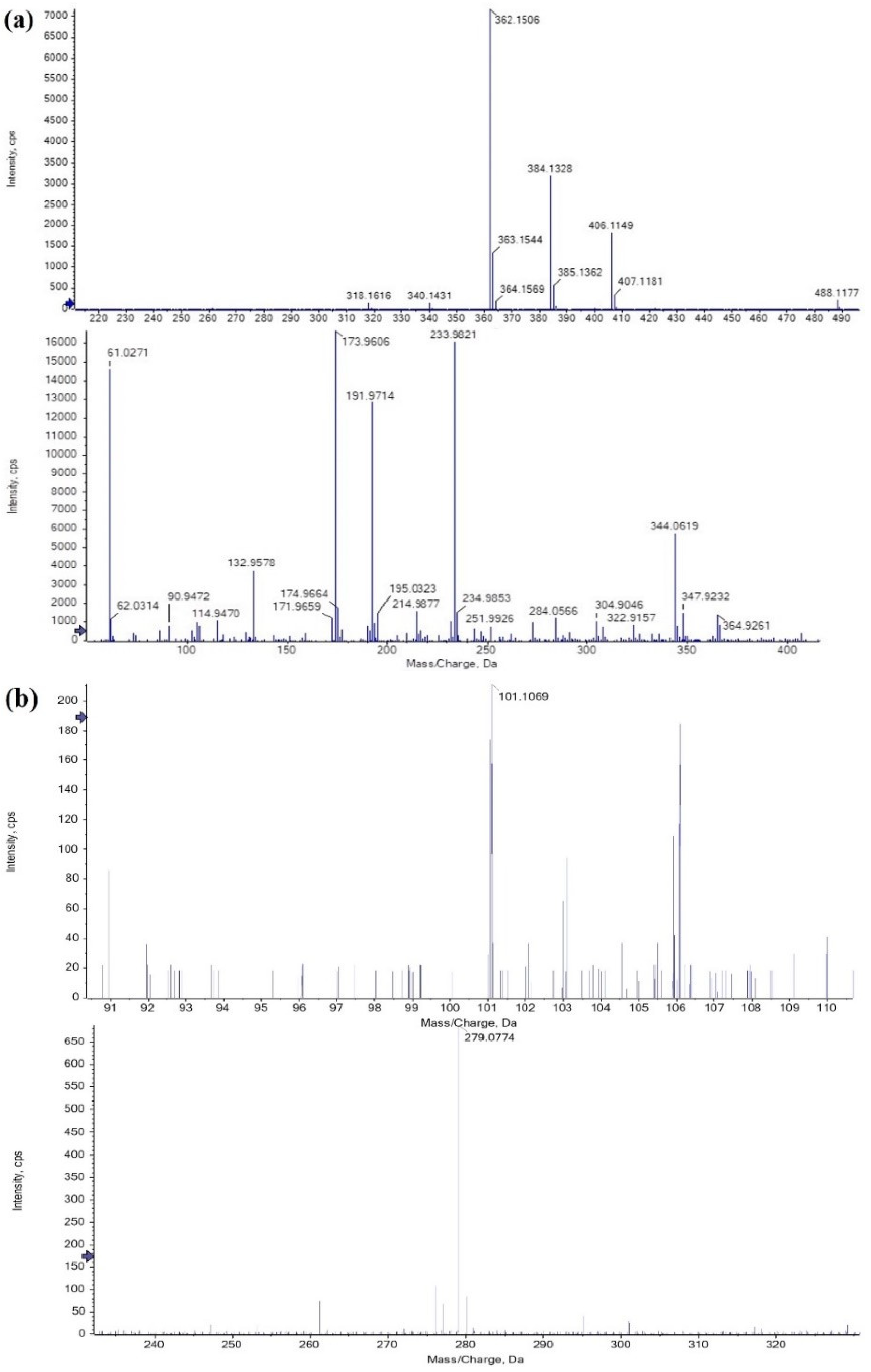
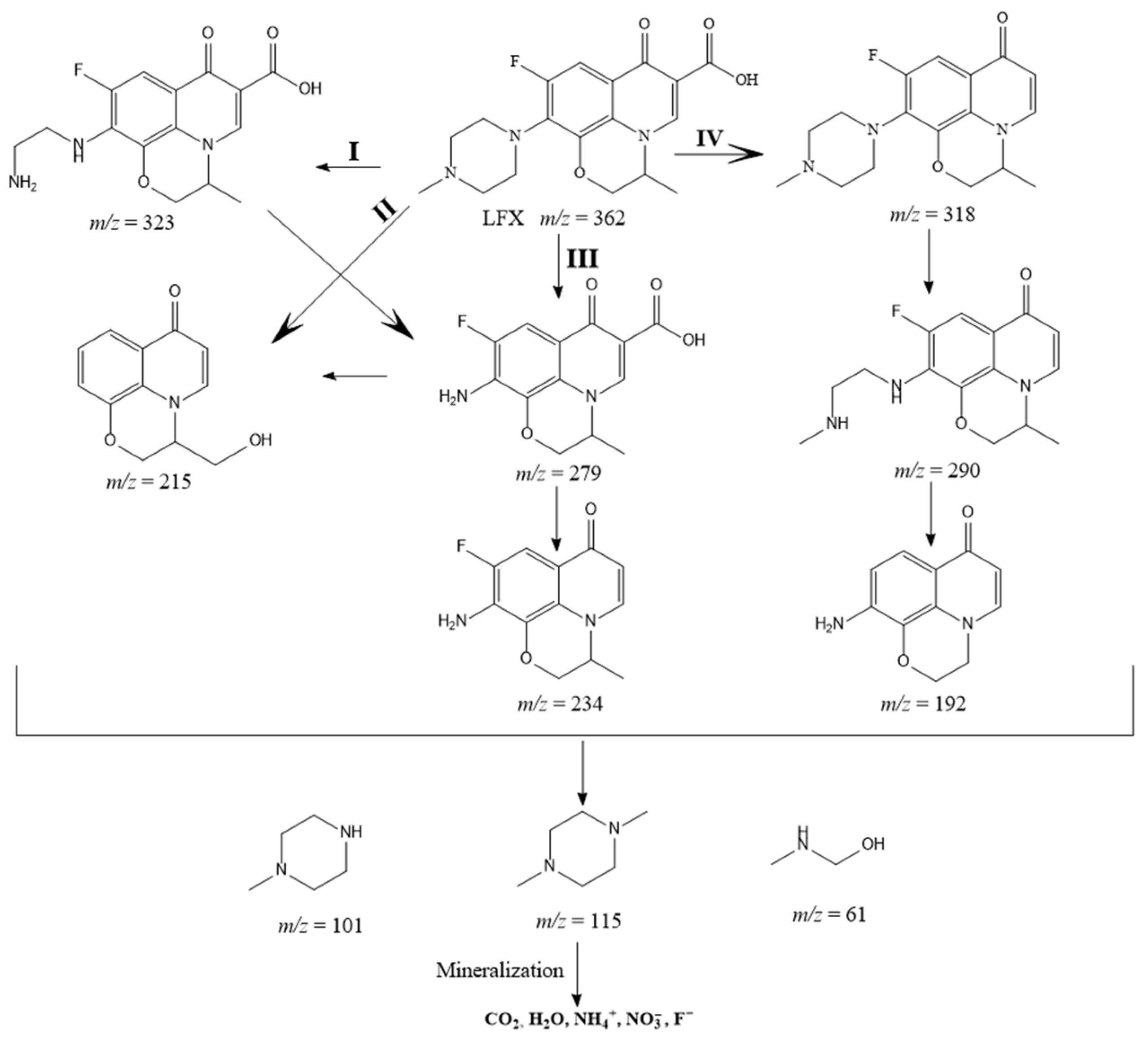
| Samples | BET Surface Area (m2g−1) | Pore Volume (cm3g−1) | Pore Size (nm) |
|---|---|---|---|
| Ce-MOF | 4.70 | 0.0034 | 32.8459 |
| Ce-MOF-450 | 40.72 | 0.0723 | 7.1008 |
| Ce-MOF-550 | 266.58 | 0.3429 | 5.1457 |
| Ce-MOF-650 | 226.83 | 0.3397 | 5.9909 |
Disclaimer/Publisher’s Note: The statements, opinions and data contained in all publications are solely those of the individual author(s) and contributor(s) and not of MDPI and/or the editor(s). MDPI and/or the editor(s) disclaim responsibility for any injury to people or property resulting from any ideas, methods, instructions or products referred to in the content. |
© 2024 by the authors. Licensee MDPI, Basel, Switzerland. This article is an open access article distributed under the terms and conditions of the Creative Commons Attribution (CC BY) license (https://creativecommons.org/licenses/by/4.0/).
Share and Cite
Mao, X.; Ou, M.; Zhao, W.; Yu, S.; Xu, H. Degradation of Levofloxacin by Electroactivated Sodium Persulfate on Carbon Cloth Cathode Modified with Cerium-Based Metal Organic Frameworks (Ce-MOF) Derivatives. Separations 2024, 11, 144. https://doi.org/10.3390/separations11050144
Mao X, Ou M, Zhao W, Yu S, Xu H. Degradation of Levofloxacin by Electroactivated Sodium Persulfate on Carbon Cloth Cathode Modified with Cerium-Based Metal Organic Frameworks (Ce-MOF) Derivatives. Separations. 2024; 11(5):144. https://doi.org/10.3390/separations11050144
Chicago/Turabian StyleMao, Xinbiao, Mingyu Ou, Wenjun Zhao, Shuangting Yu, and Hao Xu. 2024. "Degradation of Levofloxacin by Electroactivated Sodium Persulfate on Carbon Cloth Cathode Modified with Cerium-Based Metal Organic Frameworks (Ce-MOF) Derivatives" Separations 11, no. 5: 144. https://doi.org/10.3390/separations11050144
APA StyleMao, X., Ou, M., Zhao, W., Yu, S., & Xu, H. (2024). Degradation of Levofloxacin by Electroactivated Sodium Persulfate on Carbon Cloth Cathode Modified with Cerium-Based Metal Organic Frameworks (Ce-MOF) Derivatives. Separations, 11(5), 144. https://doi.org/10.3390/separations11050144





